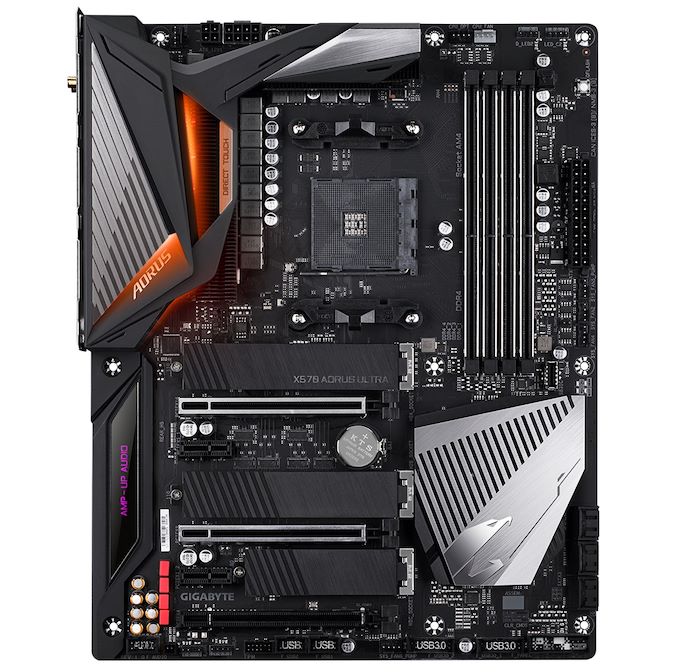The AMD X570 Motherboard Overview: Over 35+ Motherboards Analyzed
by Gavin Bonshor on July 9, 2019 8:00 AM ESTGIGABYTE X570 Aorus Ultra
The GIGABYTE X570 Aorus Ultra sits in between the X570 Aorus Master ($359) and the X570 Aorus Pro WIFI ($269) in its current product stack. The X570 Aorus Ultra is however more similar to the X570 Aorus Pro WIFI in terms of feature set with a Realtek ALC1220-VB audio codec, an Intel I211-AT Gigabit NIC, while it shares the same three PCIe 4.0 x4 M.2 slots as its more expensive brother in the X570 Aorus Ultra. This model essentially takes some features from both the board above and below in the product stack.
There are three full-length PCIe 4.0 slots which run at x16, x8/x8, and x8/x8/x4. This means the X570 Aorus Ultra has support for two-way NVIDIA SLI and up to three-way AMD CrossFire multi-graphics card configurations. Also present is two PCIe 4.0 x1 slots, while the board also benefits from three PCIe 4.0 x4 M.2 slots which each comes with its own individual heatsink. For users not adopting M.2, there are six SATA ports which have support for RAID 0, 1 and 10 arrays. The four memory slots include support for DDR4-4400 and with a maximum capacity of up to 128 GB. The aesthetics aren't as overbearing as the X570 Aorus Xtreme, but the rear panel cover which extends down to cover the audio PCB does feature integrated RGB LEDs.
On the rear panel is two USB 3.1 G2 Type-A, one USB 3.1 G2 Type-C, three USB 3.1 G1 Type-A and four USB 2.0 ports. A set of antenna ports for the Intel AX200 802.11ax Wi-Fi 6 wireless interface are present, and the single Ethernet port is controlled by an Intel I211-AT Gigabit NIC. The five 3.5 mm audio jacks and S/PDIF optical output are controlled by a Realtek ALC1220-VB HD audio codec, while a single HDMI output is featured for users to use Ryzen APUs with integrated graphics.
The GIGABYTE X570 Aorus Ultra as previously mentioned takes shades from both the model below and above with the three PCIe 4.0 x4 M.2 slots of the X570 Aorus Master while keeping the same 12+2 phase power delivery of the X570 Aorus Pro WIFI model. With an MSRP of $299, the GIGABYTE X570 Aorus Ultra doesn't include a premium NIC and for the extra $30, the X570 Aorus Master does seem to offer its worth. Users do however have the choice to run with two PCIe 4.0 x4 slots, and the GIGABYTE X570 Aorus Pro WIFI at $269 for $30 less is also an option.












225 Comments
View All Comments
DigitalFreak - Tuesday, July 9, 2019 - link
I think the only advantage of using a 2000 series CPU with an X570 board will be PCIe 3.0/4.0 support. The X370/X470 only supported PCIe 2.0. In theory, the connection from the 2000 processor to the X570 chipset should run at PCIe 3.0 speeds.FreckledTrout - Tuesday, July 9, 2019 - link
The x370 chipset and x470 both supported PCIe 3.0 with either a 1xxx or 2xxx Ryzen CPU. If you are not running a 3xxx CPU in the x570 board there isn't any major feature that should cause one to want to upgrade.DigitalFreak - Tuesday, July 9, 2019 - link
@FreckledTrout - Yes and no. The interconnect between the CPU and the chipset is PCIe 3.0 on X370 / X470, but all the PCIe lanes that come off the chipset are 2.0. Running a 2000 series CPU in an X570 board would give you a PCIe 3.0 link between the CPU and the chipset, with either PCIe 3.0 or 4.0 lanes coming off the chipset (depends on if AMD drops everything to PCIe 3.0 with a 2000 series processor).extide - Tuesday, July 9, 2019 - link
It looks like they still allow the chipset lanes to be 4.0. So you'd have 3.0 link to cpu, but 4.0 from chipset to devices.Targon - Thursday, July 11, 2019 - link
Since you have at least one or two PCI Express slots that are connected to the CPU, not chipset, that almost becomes a non-issue. On my Asus ROG Crosshair VI Hero(X370), you have PCI Express 3.0 x16 for the first slot, or x8/x8. The third PCI Express x16 slot is a 2.0 I believe, which is still enough to get the job done for many devices. Even with the X570 board with a first or second generation Ryzen processor, the most you end up with is an extra 3.0 supporting slot. Note that many boards may have x16 slots, but they are x8 electrically, so you won't see the full bandwidth anyway in those slots.sorten - Tuesday, July 9, 2019 - link
Thanks Gavin! This is a great resource and is exactly what I needed to help build my new system.willis936 - Tuesday, July 9, 2019 - link
The return of the 40mm fan! Those are the most obnoxious components ever. No one has missed them in the past ten years.Kastriot - Tuesday, July 9, 2019 - link
Buy Asrock aqua and problem solved.FreckledTrout - Tuesday, July 9, 2019 - link
I'm waiting for the next iteration of board for this reason. I'm speculating the next round the chipset will be on 7nm.abufrejoval - Tuesday, July 9, 2019 - link
The genious about that chiplet design is that the chipset doesn't actually benefit nearly as much from the shrink, as pure logic or SLC caches: The monolithic guys pay the 7nm overhead (e.g. EUV) for I/O while the geometry of the transistors in the I/O area is mostly determined by the need to power long motherbord or even slot traces.So while waiting is never a bad idea when your need clearly isn't overwhelming you, waiting for that shrink could turn out rather long. These days I/O heave chips might never be done in smaller geometries, because of that and because packaging has matured.